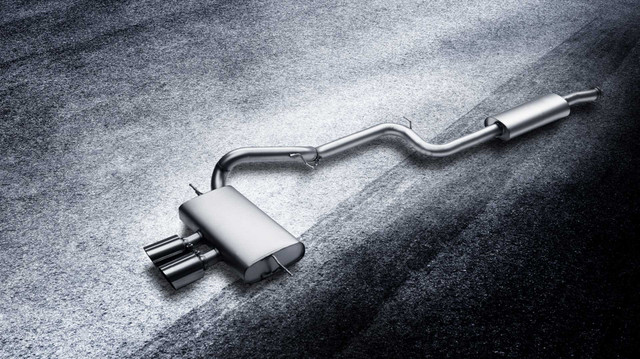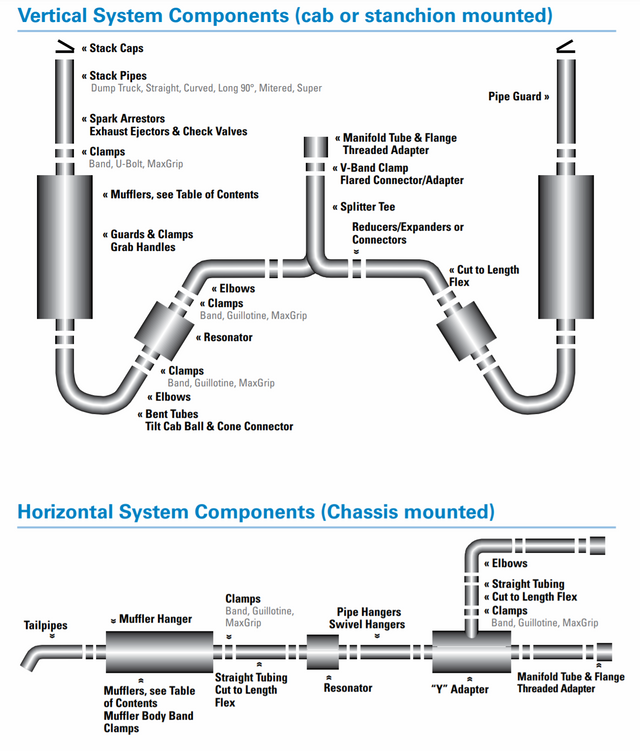What Types of Metals Are Used in Exhaust Applications?
There are a number of materials used in heavy duty exhaust applications. Some of the materials are appropriate for heavy duty applications. Other choices are not durable at the temperatures generated by gas and diesel engines and should be avoided if acceptable service life is desired. Materials selected must not only survive high temperatures, but also severe vibration, corrosive exhaust gasses, and external corroding agents such as salt and water.
The materials generally considered for exhaust parts are as follows:
Aluminized Steel is the preferred material for most heavy duty diesel applications. Aluminized Steel is a low carbon steel with a thin layer of aluminum alloyed to the surface. The aluminum provides galvanic protection for the base material. Aluminized Steel parts have an ultimate service temperature of 1250° F with a continuous duty temperature of 1100° F. This material has excellent corrosion resistance to acidic diesel exhaust gasses. Aluminized Steel parts provide excellent field life at a reasonable cost.
400 Series Steels are used for extended service life in diesel applications, and often in gas applications due to their higher operating temperatures. This material family provides slightly better strength at exhaust system temperatures than aluminized steel. The most common 400 Series Steel used in exhaust applications is Type 409. It is stronger than aluminized but has cosmetic problems at exhaust system temperature.
At first exposure to high temperature it discolors. Over time it develops a nondestructive coating of surface rust. After an extended time in the field a 409 product will display external discoloration and look worse than a similar aluminized part. Parts made with type 409 generally require some type of paint or other coating to slightly delay the onset of external discoloration, and the parts will hold a magnet due to higher iron content.
Another choice is 409 Stainless Steel with an aluminum coating. Aluminized 409 is used on Diesel Catalytic Converter mufflers due to its excellent high temperature resistance and the corrosion protection of the aluminized coating. This is a premium material found primarily on emission products or high temperature gas applications.
300 Series Stainless Steels are also applied in exhaust systems. The most common material is Type 304. This material has excellent corrosion resistance and very good high temperature strength and is used in some muffler applications where very high stresses occur. It is also used as a premium material for gas applications. The most prevalent use of the material in diesel heavy duty applications is for flex pipe. Flex pipe produced from light gauge 304 Stainless Steel is an excellent choice considering all the factors of cost, durability, and service life. In general field service life with stainless steel flex pipe is very good if the flex tubing is installed properly.
Often Chrome Plated Cold Rolled Steel parts are found on exhaust system parts. This material is a reasonable choice when a bright mirror finish is desired. Corrosion from the inside of the product can still occur, Chrome parts are very challenging to produce. It is important to produce the parts with a high level of quality because surface irregularities (and field damage to the surface) will lead to external rust.
An alternate choice for chrome parts is Bright Annealed Stainless Steel. This material provides a bright mirror like finish with excellent exhaust service life. The material is costly, but part of the cost increase is offset by using lighter gauges.
Galvanized Steel parts are sometimes used in the exhaust market. Galvanized Steel has very poor field performance. This material has an upper temperature limit of approximately 600° F. At temperatures greater than 600° F the material rapidly corrodes with a resulting degradation in appearance and probable failure.
Galvanized Steel is often used for flex pipe as a low cost replacement part. The initial low cost is offset by the limited field life of the product.
Cold Rolled Steel (CRS) is a very poor choice for any exhaust system part. This material is extremely susceptible to corrosion. These parts are only used when the lowest possible cost is desired. It is rare to find mufflers made of cold rolled steel, but there are stacks offered in some markets in Cold Rolled Steel. Clamps are another product commonly produced out of Cold Rolled Steel. Clamps are not exposed to the corrosive acids found in exhaust gasses but the high temperatures cause clamps to degrade rapidly in appearance and in function. Cold Rolled Steel clamps can be very difficult to remove after a short time in the field
Recent Posts
-
What Exhaust Parts are used in an Exhaust System?
From the manifold to the exhaust stack, you’ll find that TruckpipesUSA can be the best source for y …1st Feb 2023 -
What are Exhaust Pipes for Big Rig Trucks?
Exhaust pipes for big rig trucks are an essential component of the overall exhaust system. They play …13th Jan 2023 -
What is a Marmon connection used for?
A Marmon Connection is a method to join an exhaust connection together. It is a best pra …3rd Feb 2021



